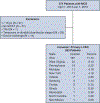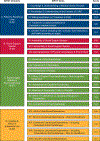Value of psychosocial evaluation for left ventricular assist device candidates
- PMID: 34053742
- PMCID: PMC10443599
- DOI: 10.1016/j.jtcvs.2021.04.065
Value of psychosocial evaluation for left ventricular assist device candidates
Abstract
Objective: Left ventricular assist devices require a psychosocial assessment to determine candidacy despite limited data correlating with outcome. Our objective is to determine whether the Stanford Integrated Psychosocial Assessment for Transplant, a tool validated for transplant and widely used by left ventricular assist device programs, predicts left ventricular assist device program hospital readmissions and death.
Methods: We performed a retrospective analysis of adults at the Cleveland Clinic with Stanford Integrated Psychosocial Assessment for Transplant scores before primary left ventricular assist device program implantation from April 1, 2013, to December 31, 2018. The primary outcome was unplanned hospital readmissions censored at death, transplantation, and transfer of care. The secondary outcome was death.
Results: There were 263 patients in the left ventricular assist device program with a median (Q1, Q3) Stanford Integrated Psychosocial Assessment for Transplant score of 16 (8, 28). During a median follow-up 1.2 years, 56 died, 65 underwent transplantation, and 21 had transferred care. There were 640 unplanned hospital readmissions among 250 patients with at least 1 outpatient visit at our center. In a multivariable analysis, Stanford Integrated Psychosocial Assessment for Transplant components but not total Stanford Integrated Psychosocial Assessment for Transplant score was associated with readmissions. Psychopathology (Stanford Integrated Psychosocial Assessment for Transplant C-IX) was associated with hemocompatibility (coefficient 0.21 ± standard error 0.11, P = .040) and cardiac (0.15 ± 0.065, P = .02) readmissions. Patient readiness was associated with noncardiac (Stanford Integrated Psychosocial Assessment for Transplant A-III, 0.24 ± 0.099, P = .016) and cardiac (Stanford Integrated Psychosocial Assessment for Transplant A-low total, 0.037 ± 0.014, P = .007) readmissions. Poor living environment (Stanford Integrated Psychosocial Assessment for Transplant B-VIII) was associated with device-related readmissions (0.83 ± 0.34, P = .014). Death was associated with organic psychopathology or neurocognitive impairment (Stanford Integrated Psychosocial Assessment for Transplant C-X, 0.59 ± 0.21, P = .006).
Conclusions: Total Stanford Integrated Psychosocial Assessment for Transplant score was not associated with left ventricular assist device program readmission or mortality. However, we identified certain Stanford Integrated Psychosocial Assessment for Transplant components that were associated with outcome and could be used to create a left ventricular assist device program specific psychosocial tool.
Keywords: SIPAT; heart transplantation; hospital readmissions; mechanical circulatory support; outcome assessment.
Copyright © 2021 The American Association for Thoracic Surgery. Published by Elsevier Inc. All rights reserved.
Conflict of interest statement
Conflict of Interest Statement
The authors reported no conflicts of interest.
The
Figures









Comment in
-
Commentary: In search of the "good candidate" for mechanical circulatory support.J Thorac Cardiovasc Surg. 2023 Mar;165(3):1122-1123. doi: 10.1016/j.jtcvs.2021.05.003. Epub 2021 May 7. J Thorac Cardiovasc Surg. 2023. PMID: 34049705 No abstract available.
-
Commentary: How to predict a harmonious relationship between patients and their left ventricular assist device?J Thorac Cardiovasc Surg. 2023 Mar;165(3):1125-1126. doi: 10.1016/j.jtcvs.2021.05.024. Epub 2021 May 19. J Thorac Cardiovasc Surg. 2023. PMID: 34059340 Free PMC article.
-
Commentary: Bringing objectivity to the nonmedical evaluation of left ventricular assist device candidates.J Thorac Cardiovasc Surg. 2023 Mar;165(3):1123-1124. doi: 10.1016/j.jtcvs.2021.05.010. Epub 2021 May 11. J Thorac Cardiovasc Surg. 2023. PMID: 34154802 No abstract available.
References
-
- Dew MA, DiMartini AF, Dobbels F, Grady KL, Jowsey-Gregoire SG, Kaan A, et al. The 2018 ISHLT/APM/AST/ICCAC/STSW recommendations for the psychosocial evaluation of adult cardiothoracic transplant candidates and candidates for long-term mechanical circulatory support. J Heart Lung Transplant. 2018;37: 803–23. - PubMed
-
- Bui QM, Allen LA, LeMond L, Brambatti M, Adler E. Psychosocial evaluation of candidates for heart transplant and ventricular assist devices: beyond the current consensus. Circ Heart Fail. 2019;12:e006058. - PubMed
-
- Bruce CR, Delgado E, Kostick K, Grogan S, Ashrith G, Trachtenberg B, et al. Ventricular assist devices: a review of psychosocial risk factors and their impact on outcomes. J Card Fail. 2014;20:996–1003. - PubMed
-
- Lundgren S, Lowes BD, Zolty R, Burdorf A, Raichlin E, Um JY, et al. Do psychosocial factors have any impact on outcomes after left ventricular assist device implantation? ASAIO J. 2018;64:e43–7. - PubMed
Publication types
MeSH terms
Grants and funding
LinkOut - more resources
Full Text Sources
Other Literature Sources
Medical
Miscellaneous

